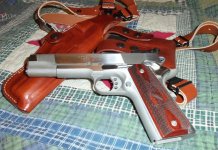HBW1412
Member
I am trying to work up a load of 9mm and can't seem to find any consistant load data.
I am using 115 gr. Berry's Plated Round Nose bullets and have a keg of PowerPistol powder.
There aren't any published data with this particular combination. I know about using low to mid range jacketed combinations for plated bullets, but this is where I'm having the issue.
The 49th Lyman doesn't give any information for a 115gr. round nose.
The Sierra Edition V 4th Printing gives a range of 5.1 - 6.0 grains of PowerPistol for a 115 gr. FMJ.
The Speer Number 13 Manual gives a range of 6.2 - 6.7 grains for a 115 gr. TMJ. Speer gives a starting grain 2/10 of a grain higher than the Sierra Manuals Maximum Load.
I have never used PowerPistol powder before, so I am not familiar with its characteristics.
I am tempted to go with the Speer manual because it is for a TMJ which is Speers version of a plated bullet.
Does anyone have any experience using PowerPistol with 115gr. plated round nose bullets?
I am using 115 gr. Berry's Plated Round Nose bullets and have a keg of PowerPistol powder.
There aren't any published data with this particular combination. I know about using low to mid range jacketed combinations for plated bullets, but this is where I'm having the issue.
The 49th Lyman doesn't give any information for a 115gr. round nose.
The Sierra Edition V 4th Printing gives a range of 5.1 - 6.0 grains of PowerPistol for a 115 gr. FMJ.
The Speer Number 13 Manual gives a range of 6.2 - 6.7 grains for a 115 gr. TMJ. Speer gives a starting grain 2/10 of a grain higher than the Sierra Manuals Maximum Load.
I have never used PowerPistol powder before, so I am not familiar with its characteristics.
I am tempted to go with the Speer manual because it is for a TMJ which is Speers version of a plated bullet.
Does anyone have any experience using PowerPistol with 115gr. plated round nose bullets?

